

 |
The Farnsworth
Invention: Fact -v- Fiction
|
 |
Act II, Scene 2: In which demonstrations fail (and succeed) |
| The Play |
The Facts
|
|
| "He has a son now..." | Phil and Pem's first son, Philo T. Farnsworth III, was born in 1929. A second son, Kenny, was born in 1931. | |
| "Crocker, Everson and Gorrell had lost faith... and money..." | As noted earlier, William Crocker was not involved in the Farnsworth television enterprise although it was first conceived under his bank's roof. Roy Bishop had also sold his interest, and now Jess McCargar was the principle backer, and he raised money by issuing and selling stock in the venture. The effort was made more difficult by the Crash of '29 and ensuing financial crises, but the word "television" was often enough to evoke interest and fresh infusions of funds. |  By the early 1930s, television was beginning to look like... well, television. |
| Farnsworth demonstrates television for the principles in United Artists -- Mary Pickford, Douglas Fairbanks and Joseph Schenck. He is portrayed as showing up late -- and drunk -- and complains that his system doesn't really work -- that "light problem" again... | Mary Pickford, Douglas Fairbanks, and UA business manager Joseph Schenck visited Farnsworth's San Francisco lab in 1930. The lab gang made some adjustments to the system the day before the scheduled visit. Despite working through the night to find the problem, the lab gang was unable to produce any kind of picture when the celebrity guests arrived. No sooner had they left than a loose wire was found. | 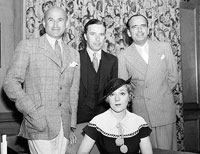 The United Artists - DW Griffith, Charlie Chaplin, Douglas Fairbanks and Mary Pickford |
| Pem enters and informs Phil that "Kenny still has a cough." | Pem and Phil's infant son was stricken with strept throat in 1932, after they had all relocated to Philadelphia. | |
There's an explanation of the television system that begins with "photons being excited... and manipulated..." And this explanation ends with "but it doesn't work..." |
There are three or four explanations of Farnsworth's invention in the course of the play, and they all differ slightly. In this case, it's not really photons that get excited and manipulated, it's electrons. And it worked, really. Just not the afternoon when Mary Pickford was there. But that was because of a broken or loose wire, not because of any "light problem." |
|
| Farnsworth goes off his rocker slightly, "we're going out of our minds" trying to figure out why it takes so much light to produce a decent picture. | Farnsworth followed his own path, and his ideas produced inventions that not only improved the sensitivity of his tubes, but produced tremendous advances in amplification and opened new fields of quantum science. He may have had trouble keeping his backers in line, or confronting the likes of David Sarnoff in patent licensing issues, but in the lab itself he had no equal. | 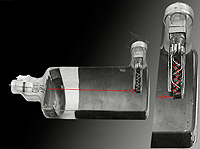 This cross section of an Image Dissector shows the Electron Multiplier, a Farnsworth innovation that improved light sensitivity that found its way into later camera tubes. |
| The scene with United Artists is followed by a confrontation between Farnsworth and "William Crocker." | Though "Crocker" is a fictional construction, the conflict portrayed here was quite real. In 1933, Farnsworth left Philco and started his own lab, which compelled Jess McCargar to start raising money again. Through the mid 30s, RCA did everything it could to discourage potential licensees from doing business with Farnsworth, which left McCargar little choice but to resume peddling stock in the venture. |
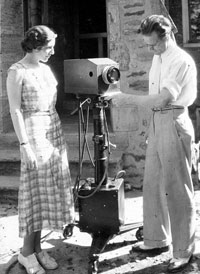 Setting up a camera outside the new lab on Mermaid Lane in Philadelphia |
| Farnsworth dwells on the "light problem," certain that it is something "right under our noses." | By this time the Farnsworth Television Labs controlled dozens of patents that were absolutely indispensable for the art of electronic television. Improving sensitivity was just one of the issues, and, as stated, Farnsworth had plenty to offer on the subject. | |
| Crocker asks Farnsworth when he will have "a picture suitable for commercial broadcast." Farnsworth can't answer him. | In the summer of 1934, the Franklin Institute in Philadelphia conducted the first public demonstration of television. For the occasion, Farnsworth built a large receiver, and a special camera, and transmitted pictures from the roof to enthusiastic audiences in an auditorium downstairs. The technology was ready for public consumption, but the industry was not ready to make it available. After all, there were still radio patents that had not run their course... |
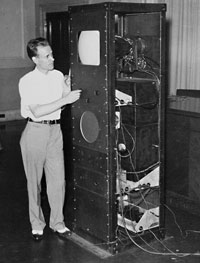 |
Want the whole story? Read a Book! |
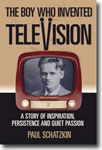 The Boy Who Invented Television A Story of Inspiration, Persistence, and Quiet Passion by Paul Schatzkin |
|